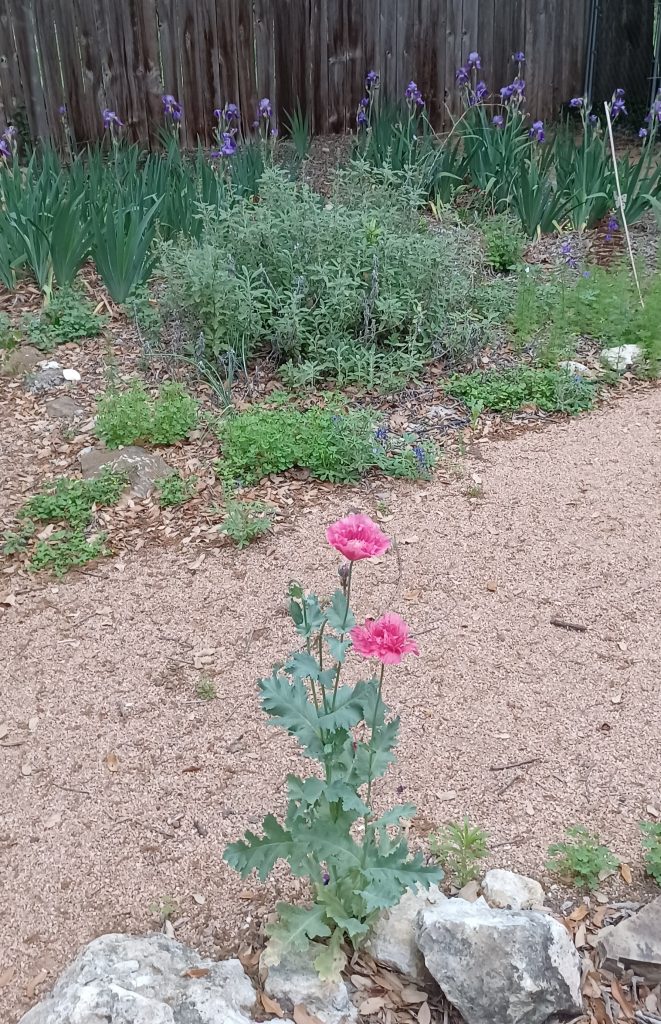By Mary Cennamo, Bexar County Master Gardener
May 2023

There are more than 310 species of irises on record. This beautiful flower is characterized by a wide assortment of colors, varying heights and multiple seasonal blooming times. Irises may be “bearded” or “beardless.”
Bearded refers to the part of the flower that is above the fall (or at the top of the falling petal) and which usually has a contrasting color that helps the flower beautifully stand out in the garden. Most bearded irises are native to central and southern Europe. In contrast, beardless irises do not have the “beard” and mainly originated in Asia.
Short or Tall?
Irises can be short or tall. In general, the shorter varieties usually bloom earlier than the taller varieties, a blooming trend that I recently read about. But, as always, there are exceptions to the rule. There can be taller varieties that bloom early, and in my garden, I have a very tall bearded variety with multiple flowers up the stem that blooms for about two weeks in early April.
I recommend planting some of each so that you have continuous flowers blooming in your garden.
Propagating Irises
The iris is a rhizome with nodes along the stem from which the iris plants grow and propagate. The word Rhizome is derived from the Greek rhizoma, meaning “a bunch of roots.”
Rhizomes are often confused with roots: while they may look like roots, they are actually modified and advanced plant stems positioned horizontally or vertically under the ground, with shoots coming out from the nodes and surrounded by scale-like green leaves or buds. These rhizomes store proteins, nutrients, starches, and glucose to help plants survive under unfavorable environmental conditions.
A single rhizome eventually becomes five or even more and should be divided when they get too crowded. Bearded irises often become overcrowded within a few years, resulting in fewer flowers. Indeed, irises move through the country by sharing these rhizomes with neighbors, friends, and family.
When you do divide them, avoid planting the rhizome too deep in the soil as you would a bulb. Instead, half of the rhizome should be above ground. The roots will then grow below the soil and help fortify and protect the plant from wind and other disruptions.
Re-blooming Irises
According to the Reblooming Iris Society, irises can re-bloom:
- Some bloom in the spring as well as in the fall (“cycle rebloomers”);
- Some produce two or more blooms in a year (“remontant bloomers”);
- Some bloom and immediately bloom again ( “repeaters” ); and,
- Some bloom year-round.
I decided to add some of these re-bloomers to my garden this past year in an effort to have flowering irises throughout the year. Some of the more reliable re-bloomers include:
- Autumn Trist: a light purple and white colored midseason bloomer that can reach a height of 34 inches;
- Bountiful Harvest: a dark purple or violet iris with a white fall, an early bloomer that reaches about 33 inches;
- Harvest of Memories: a totally yellow variety that reaches 40 inches and flowers midseason;
- Immortality: a white variety that reaches 30 inches and blooms midseason; and
- Sugar Blues: a blue variety that can reach a height of 36 inches and blooms midseason to late season.
According to my research, the Immortality white variety is said to be one of the most successful in gardens.
Spotlight: The Cemetery Iris (Iris albicans)
The Cemetery Iris (Iris albicans) is a very short-bearded white iris and is one of the first to bloom in the spring. This heirloom variety was first grown in cemeteries in North Africa. Eventually, the rhizomes were carried to Spain and then on to the New World.
Iris albicans can be seen in cemeteries all across the country in early April. It is a single bloom type and does not re-bloom in the fall. This beautiful iris needs very little care—no need to fertilize or to add extra water once established—which may be why it thrives at cemeteries. The Iris albican also has a blue variety but is not nearly as prevalent as the white.
Tips for Growing Irises

To successfully grow irises, you should plant them in a site that receives at least 6 hours of direct sun daily in well-drained soil, as they do not tolerate soggy or wet soils. Irises are excellent plants for perennial beds and borders and are hardy in USDA Hardiness Zones 3 to 10.
Irises must be fertilized. I usually fertilize mine in the springtime with compost only. In the past, I have been rewarded with only about 10 flowers across my iris garden during the blooming period. This year, after doing some research, I used an organic fertilizer (10-10-10) in addition to the compost, and I will fertilize again after they finish blooming in two weeks. This second fertilizing almost guarantees that your irises will bloom the following spring. Leaf mulch is also effective in protecting and promoting growth but you should make sure not to cover the rhizome.
One of the reasons that I love irises is that they attract butterflies and hummingbirds to my yard, simply by their beautiful colors and intoxicating aroma. For example, my light purple bearded variety has a vanilla fragrance that draws in butterflies, hummingbirds…..and me!
While I love looking at my iris garden as they bloom and as butterflies flutter about, I also enjoy bringing cut flowers into the house to enjoy the vanilla fragrance. And, they will last for some time in a vase. I usually cut them in the morning, and that seems to make them last longer throughout the week.
In short, I recommend that you plant irises in your garden! They like the San Antonio dry summers, and while you have to work a little to make them thrive, the long-lasting bloom is well-worth the effort.
Photos by Author

